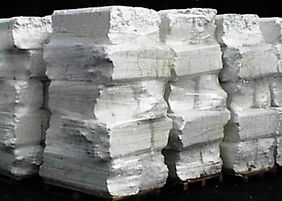Information about different types of foam
What is EPS Foam
EPS is Expanded Polystyrene Foam. Polystyrene is one of the most common forms of plastic. It s a polymer made from the monomer styrene, a liquid hydrocarbon that is commercially manufactured from petroleum by the chemical industry.
At room temperature, polystyrene is normally a solid thermoplastic, but can be melted at higher temperature for molding or extrusion, then resolidified.
Styrene is an aromatic monomer, and polystyrene is an aromatic polymer.
Polystyrene's most common use is as expanded polystyrene (EPS). Expanded polystyrene is produced from a mixture of about 90-95% polystyrene and 5-10% gaseous blowing agent, most commonly pentane or carbon dioxide. Through the use of heat, usually stem, the solid plastic is expanded into foam.
Expanded Polystyrene (EPS) is 100% recyclable and is being recycled by businesses and consumers across the world. EPS can easily be recycled into new foam packaging or durable consumer goods like cameras, coat hangers, CD jewel cases and more.

What is XPS Foam
XPS foam, also known as Extruded Polystyrene foam, has an innate combination of properties that make it one of the most efficient insulating materials available.
The closed-cell structure, responsible for the foam’s excellent moisture resistance, also contributes to its high compressive strength and superior thermal performance.
The most common use of XPS is as insulation for roofs. Also, Extruded polystyrene has a well established reputation for long-term reliability and superior resistance to the elemental forces of nature: time, water, cold, heat, and pressure. XPS material is also used in crafts and model building, in particular architectural models.
Other XPS applications include:
Walls, Exterior Insulation Finish Systems (EIFS), Insulating Concrete Form Systems (ICFs), Structural Insulated Panels (SIPs), Earth shelters, Swimming pools, Recreational vehicles, Agricultural buildings, Low temperature spaces, Ice rinks, Precast concrete systems, Plaza decks, Highway insulation, Airport runway insulation XPS has a closed, uniform cell structure which is stronger than EPS and has a smoother surface. For the same reason, XPS is also harder to compress and to recycle.

What is Polyethelyne Foam
Polyethylene (also known as PE ) is a semi-rigis foam produced through the polymerization of ethylene. It is a durable lightweight closed-cell material formed in a mold, resulting in a sheet of foam known as a bun. It is often used for packaging due to its good insulation properties, and its high resistance to chemicals and moisture, keeping the packaging content safe. The material is easy to process and fabricate and is cost-effective - a thin layer is good enough for packaging. It is also used for vibration dampening and insulation. PE is similar to EVA foam, but is firmer, more resistant to heat and is more cost-effective.

What is Polyurethane Foam
A polyurethane (commonly known as PU) is any polymer consisting of a chain of organic units joined by urethane links. It is widely used in flexible and rigid foams, durable elastomers and high-performance adhesives and sealants, fibers, seals, gaskets, condoms, carpet underlay, and hard plastic parts. Polyurethane products are often called "urethanes". They should not be confused with the specific substance urethane, also known as ethyl carbamate. Polyurethanes are not produced from ethyl carbamate, nor do they contain it.
Polyurethane foam is a light firm hydrothermal insulation material with a specific structure that stipulates the lowest thermal conductivity rate and the least water-absorbing compared to other heat insulation materials.
flexible polyurethane is commonly used in upholstery fabrics in commercial and domestic furniture and mattresses; rigid polyurethane is inside the metal and plastic walls of most refrigerators and freezers, or behind paper, metals and other surface materials in the case of thermal insulation panels in the construction sector.
Polyurethane is recycled in two primary ways: mechanical recycling, in which the material is reused in its polymer form, and chemical recycling that takes the material back to its various chemical constituents.

What is Polypropylene Foam
Polypropylene (Also known as EPP Foam) is a thermoplastic polymer resin.
It is a part of the average household as well as commonly used in commercial and industrial applications.It is versatile and is used in products such as the following: Plastic parts - from toys to automobile products, Carpeting and in upholstery, Reusable products - especially in containers and similar product, Stationary paper and writing bindings, Technology - commonly found in loudspeakers and similar types of equipment, laboratory equipment - in virtually every aspect where plastics are found.
Polypropylene is best recycled by melting the product.
The PP products are fed into an extruder of a hot melting machine, where it is melted at about 4640F (2400C) and cut into little granules.

